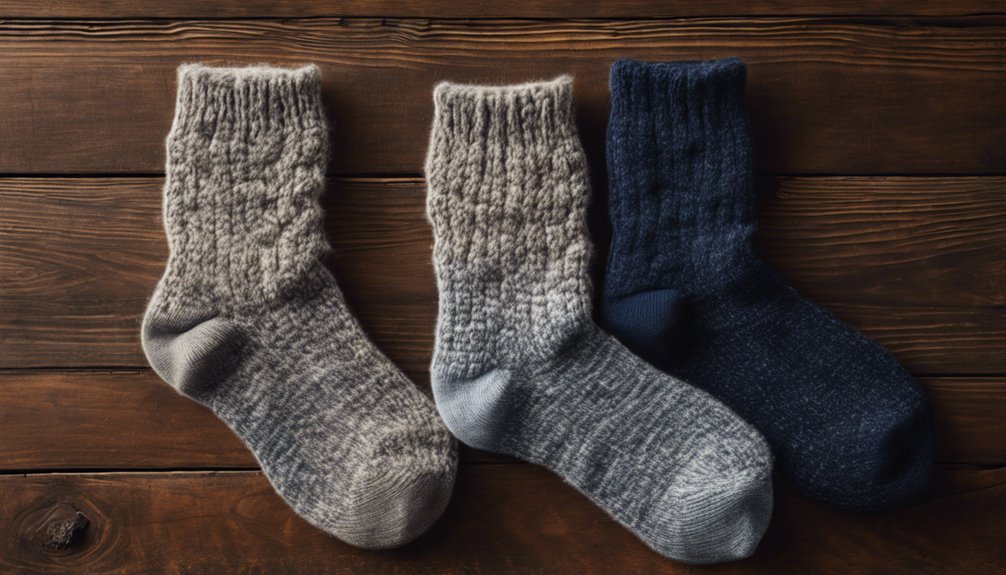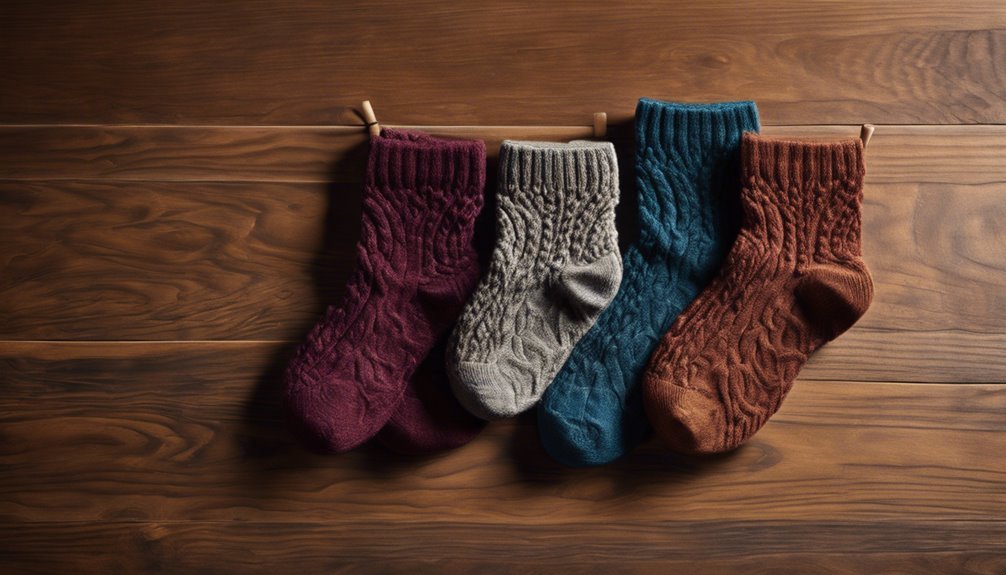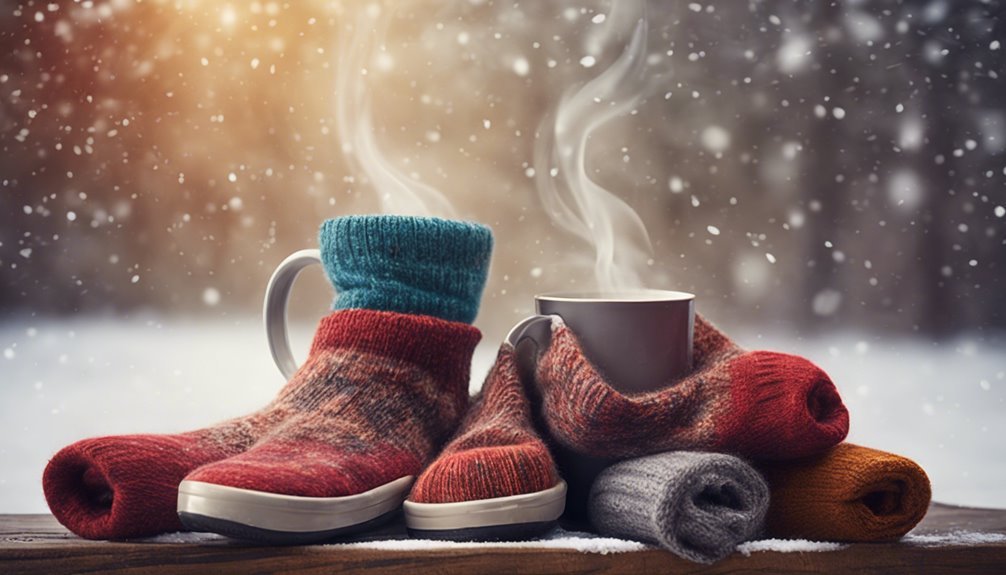Cold-Weather Boot Socks vs. Regular Wool Socks: Which Keeps Feet Warmer?
When comparing cold-weather boot socks to regular wool socks, the boot socks generally keep your feet warmer. They use specialized materials, like wool blends, designed for better insulation and moisture management. Their thickness and strategic cushioning enhance comfort while preventing sweat buildup. Regular wool socks provide good warmth but may not offer the same level of thermal regulation or reinforcement. Understanding these differences can help you make an informed choice for your specific needs. More insights await you.
Understanding Cold-Weather Boot Socks

When it comes to choosing the right socks for cold weather, understanding cold-weather boot socks is vital. These socks are designed specifically to enhance thermal properties, keeping your feet warm in freezing temperatures. Look for materials like merino wool or synthetic blends, which provide superior insulation while wicking moisture away. Proper sock care is important; always wash them according to the manufacturer's instructions to maintain their insulating qualities. Avoid fabric softeners, as they can disrupt the sock's ability to regulate temperature. When selecting socks, consider the thickness and cushioning to guarantee a comfortable fit within your boots. Prioritizing these features will help you enjoy freedom of movement and warmth during your outdoor adventures in cold weather.
Exploring Regular Wool Socks
Regular wool socks are a versatile choice for everyday wear, offering excellent insulation and moisture-wicking properties. The history of wool dates back thousands of years, making it a trusted material for warmth and durability. When you opt for regular wool socks, you gain several benefits:
- Natural insulation keeps your feet warm.
- Moisture-wicking properties prevent sweat buildup.
- Breathability reduces odor and discomfort.
- Durability guarantees long-lasting performance.
These socks can shift seamlessly from outdoor adventures to casual days around town. While they're not as specialized as cold-weather boot socks, regular wool socks provide a comfortable balance for many activities. Embrace the benefits of wool, and enjoy the freedom of movement while keeping your feet cozy and dry.
Key Differences in Materials
While regular wool socks offer numerous advantages, cold-weather boot socks are designed with specific materials that enhance their performance in frigid conditions. These specialized materials often integrate synthetic fibers, promoting better thermal regulation and moisture-wicking properties. This guarantees your feet remain dry and warm during extended outdoor activities.
| Material Type | Thermal Regulation | Sock Longevity |
|---|---|---|
| Merino Wool | Moderate | High |
| Synthetic Blends | High | Moderate |
| Heavyweight Wool | High | High |
| Coolmax | Very High | Moderate |
| Alpaca Wool | Moderate | High |
Design Features for Insulation

Although cold-weather boot socks may seem similar to regular wool socks, their design features are specifically tailored to enhance insulation and overall warmth. The sock construction prioritizes thermal layering, allowing for an effective heat-retention system. Here are some key design elements that improve insulation:
- Thicker yarns for enhanced warmth
- Strategic cushioning in high-impact areas
- Moisture-wicking properties to keep feet dry
- Reinforced sections for durability and warmth retention
These elements work together to create a barrier against cold, ensuring your feet stay cozy during outdoor activities. When choosing your socks, remember that these specialized features are what set cold-weather boot socks apart, providing the freedom to explore without the chill.
Comfort and Fit Considerations
When selecting cold-weather boot socks, comfort and fit are crucial for maintaining warmth and preventing discomfort during extended wear. The right sock length can considerably affect your experience, as longer socks typically offer better coverage and warmth. Additionally, cushioning options play an essential role in providing comfort.
Here's a quick comparison to help you decide:
| Sock Length | Cushioning Options |
|---|---|
| Crew | Light Cushioning |
| Over-the-Calf | Medium Cushioning |
| Ankle | Heavy Cushioning |
| Knee High | No Cushioning |
Ultimately, the perfect combination of sock length and cushioning will support your feet, keep them warm, and enhance your overall comfort while enjoying your outdoor adventures.
Choosing the Right Socks for Your Needs
When choosing socks for cold weather, you'll want to take into account material composition, thickness, and moisture-wicking capabilities. Different materials offer varying levels of insulation and breathability, affecting your comfort during outdoor activities. Understanding these factors will help you select the right socks to meet your specific needs.
Material Composition Differences
Understanding the material composition of cold-weather boot socks compared to regular wool socks is essential for making an informed choice that suits your needs. Here's what you should consider:
- Sock Durability: Cold-weather boot socks often use reinforced fibers for increased longevity.
- Thermal Regulation: Specialized materials enhance heat retention and moisture-wicking capabilities.
- Blends: Look for blends that include merino wool and synthetic fibers for superior performance.
- Weight: Heavier sock materials can offer better insulation but may affect comfort.
Choosing the right material guarantees your feet stay warm without compromising on durability or comfort. Cold-weather boot socks excel in providing the necessary thermal regulation, making them the ideal choice for extreme conditions.
Thickness and Insulation Levels
The thickness of your socks plays a significant role in determining insulation levels, which directly impacts your comfort in cold weather. Thicker socks generally provide better heat retention, keeping your feet warm during chilly excursions. However, it's crucial to take sock layering into account; using a thin moisture-wicking liner sock beneath a thicker insulating sock can optimize warmth without compromising fit. This combination allows for better airflow and minimizes bulk inside your boots. When choosing socks, think about the specific conditions you'll face. If you're venturing into extreme cold, go for heavy-duty cold-weather boot socks. For milder conditions, regular wool socks may suffice. Ultimately, balancing thickness and insulation levels guarantees your feet stay warm and comfortable, giving you the freedom to enjoy outdoor activities.
Moisture-Wicking Capabilities
While selecting socks for cold weather, it's essential to take into account moisture-wicking capabilities, as damp feet can lead to discomfort and even frostbite. Look for socks that excel in moisture management and provide excellent sock breathability. Here are some key features to keep in mind:
- Material: Opt for synthetics or blends designed for moisture control.
- Fit: A snug fit helps in moisture wicking, preventing bunching.
- Ventilation: Look for strategic mesh zones for enhanced breathability.
- Durability: Verify the socks can withstand cold conditions without losing their moisture-wicking properties.
Frequently Asked Questions
Can I Wear Cold-Weather Boot Socks in Warmer Temperatures?
You can wear cold-weather boot socks in warmer temperatures, but consider temperature adaptability and sock breathability. If they're too insulating, your feet may overheat. Choose lightweight materials for comfort during milder conditions.
How Often Should I Wash My Wool Socks?
When it comes to sock care, you shouldn't shy away from washing your wool socks. Ideally, you should wash them every few wears, about every 3-5 uses, to maintain their freshness and longevity.
Are There Specific Brands Recommended for Cold-Weather Boot Socks?
When considering brands for cold-weather boot socks, look for those utilizing high-quality materials like merino wool or synthetic blends. Popular choices include Smartwool and Darn Tough, known for durability and warmth in brand comparisons.
What Is the Average Lifespan of Wool Socks?
Wool socks typically last one to three years, depending on usage and care. When considering sock material comparison, wool sock durability stands out, as they resist wear and retain warmth better than synthetic alternatives.
Can I Wear Regular Wool Socks for Hiking?
You can totally wear regular wool socks for hiking, but don't underestimate sock thickness! For ideal hiking comfort, choose socks that provide cushioning and moisture-wicking properties to keep your feet happy on those adventurous trails.







